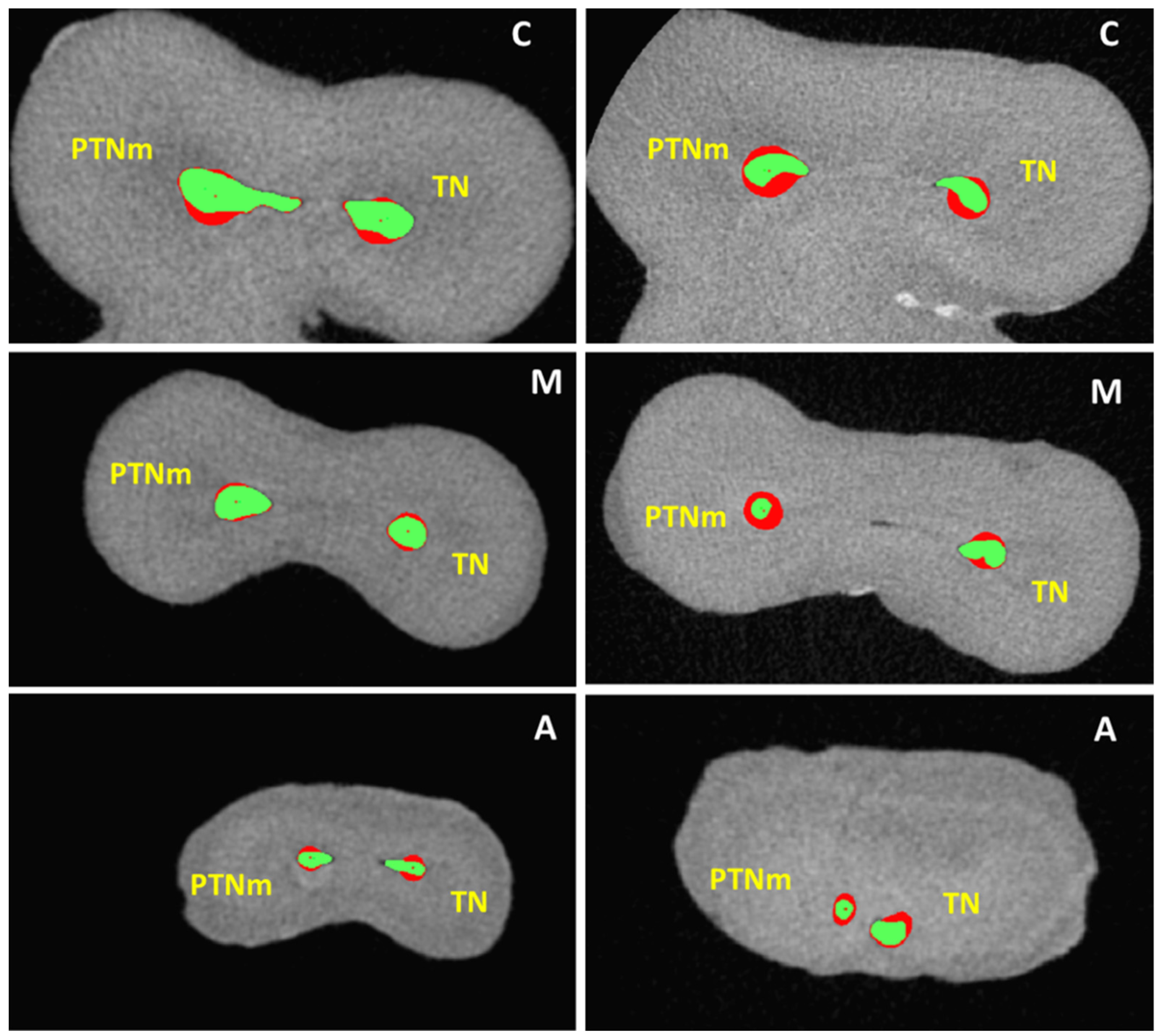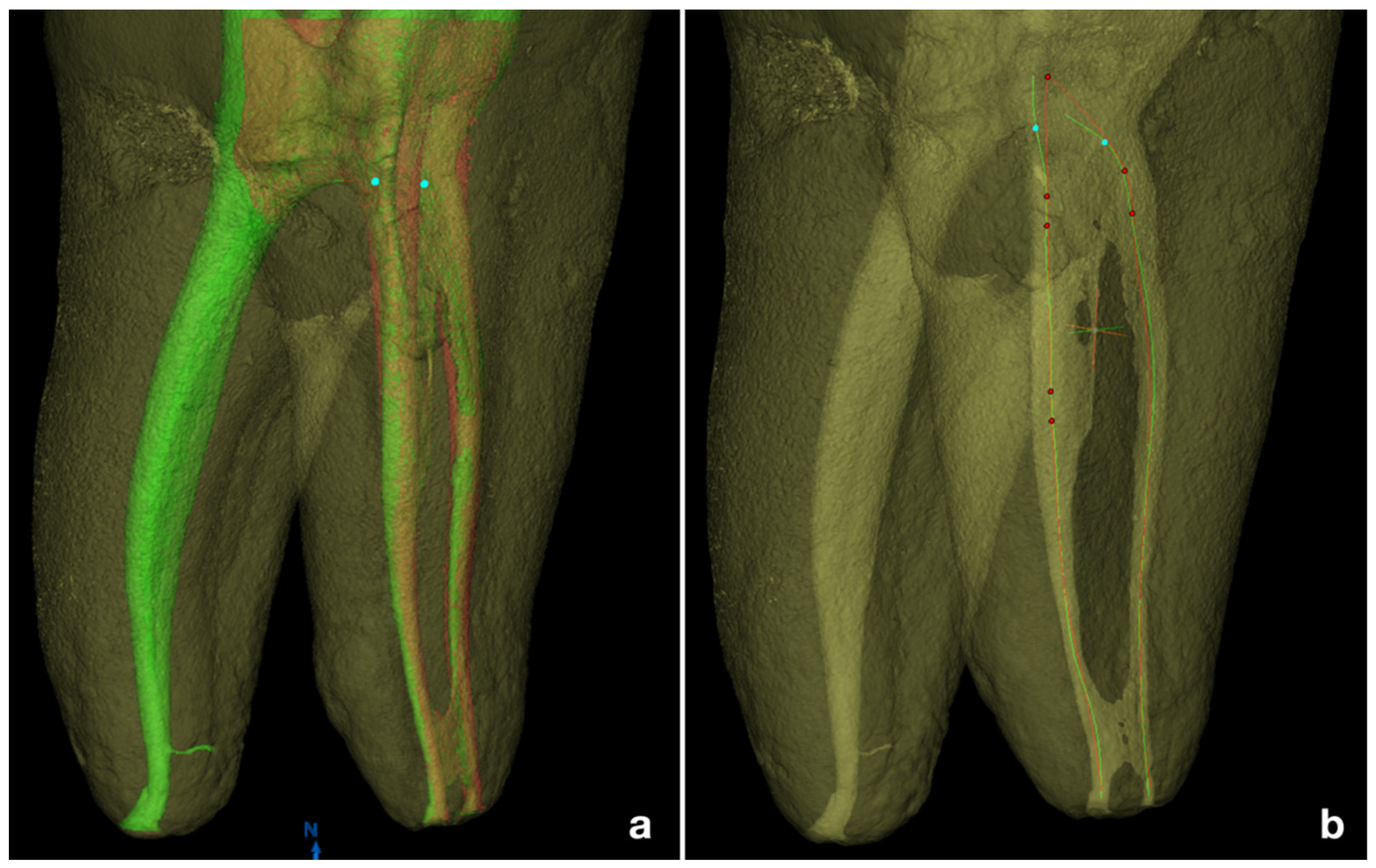Micro-Computed Tomography Evaluation of Minimally Invasive Shaping Systems in Mandibular First Molars
Abstract
1. Introduction
2. Materials and Methods
2.1. Samples Selection
2.2. Samples Preparation
2.3. Micro-Computed Tomography Analysis
2.4. Statistical Analyses
3. Results
4. Discussion
Author Contributions
Funding
Institutional Review Board Statement
Informed Consent Statement
Acknowledgments
Conflicts of Interest
References
- Peters, O.A. Current challenges and concepts in the preparation of root canal systems: A review. J. Endod. 2004, 30, 559–567. [Google Scholar] [CrossRef] [PubMed]
- Metzger, Z.; Solomonov, M.; Kefir, A. The role of mechanical instrumentation in the cleaning of root canals. Endod. Top. 2013, 29, 87–109. [Google Scholar] [CrossRef]
- Hulsmann, M.; Peters, O.A.; Dummer, P.M.H. Mechanical preparation of root canals: Shaping goals, techniques and means. Endod. Top. 2005, 10, 30–76. [Google Scholar] [CrossRef]
- American Association of Endodontists (2008) Colleagues for Excellence. Rotary Instrumentation: Endodontic Perspective. Available online: http://www.aae.org/uploadedfiles/publications_and_research/endodontics_colleagues_for_excel-lence_newsletter/winter08ecfe.pdf (accessed on 1 June 2022).
- Berutti, E.; Paolino, D.S.; Chiandussi, G.; Alovisi, M.; Cantatore, G.; Castellucci, A.; Pasqualini, D. Root canal anatomy preservation of WaveOne reciprocating files with or without glide path. J. Endod. 2012, 38, 101–104. [Google Scholar] [CrossRef] [PubMed][Green Version]
- Haapasalo, M.; Shen, Y. Evolution of nickel-titanium instruments: From past to future. Endod. Top. 2013, 29, 3–17. [Google Scholar] [CrossRef]
- Alovisi, M.; Cemenasco, A.; Mancini, L.; Paolino, D.; Scotti, N.; Bianchi, C.C.; Pasqualini, D. Micro-CT evaluation of several glide path techniques and ProTaper Next shaping outcomes in maxillary first molar curved canals. Int. Endod. J. 2017, 50, 387–397. [Google Scholar] [CrossRef]
- Sousa-Neto, M.D.; Silva-Sousa, Y.C.; Mazzi-Chaves, J.F.; Carvalho, K.K.T.; Barbosa, A.F.S.; Versiani, M.A.; Jacobs, R.; Leoni, G.B. Root canal preparation using micro-computed tomography analysis: A literature review. Braz. Oral. Res. 2018, 18, 32–66. [Google Scholar] [CrossRef]
- Morales, M.D.L.N.; Sánchez, J.A.G.; Olivieri, J.G.; Elmsmari, F.; Salmon, P.; Jaramillo, D.E.; Terol, F.D.S. Micro-computed Tomographic Assessment and Comparative Study of the Shaping Ability of 6 Nickel-Titanium Files: An In Vitro Study. J. Endod. 2021, 47, 812–819. [Google Scholar] [CrossRef]
- Elnaghy, A.M.; Elsaka, S.E. Assessment of the Mechanical Properties of ProTaper Next Nickel-Titanium Rotary Files. J. Endod. 2014, 40, 1830–1834. [Google Scholar] [CrossRef]
- Zhao, D.; Shen, Y.; Peng, B.; Haapasalo, M. Root Canal Preparation of Mandibular Molars with 3 Nickel-Titanium Rotary Instruments: A Micro-Computed Tomographic Study. J. Endod. 2014, 40, 1860–1864. [Google Scholar] [CrossRef]
- Alovisi, M.; Pasqualini, D.; Scotti, N.; Carpegna, G.; Comba, A.; Bernardi, M.; Tutino, F.; Dioguardi, M.; Berutti, E. Micro-CT evaluation of rotary and reciprocating glide path and shaping systems outcomes in maxillary molar curved canals. Odontology 2022, 110, 54–61. [Google Scholar] [CrossRef] [PubMed]
- Scattina, A.; Alovisi, M.; Paolino, D.S.; Pasqualini, D.; Scotti, N.; Chiandussi, G.; Berutti, E. Prediction of Cyclic Fatigue Life of Nickel-Titanium Rotary Files by Virtual Modeling and Finite Elements Analysis. J. Endod. 2015, 41, 1867–1870. [Google Scholar] [CrossRef] [PubMed]
- Peters, O.A.; Arias, A.; Choi, A. Mechanical properties of a novel nickel-titanium root canal instrument: Stationary and dynamic tests. J. Endod. 2020, 46, 994–1001. [Google Scholar] [CrossRef] [PubMed]
- Elnaghy, A.M.; Elsaka, S.E.; Elshazli, A.H. Dynamic cyclic and torsional fatigue resistance of TruNatomy compared with different nickel-titanium rotary instruments. Aust. Endod. J. 2020, 46, 226–233. [Google Scholar] [CrossRef]
- Gu, Y.; Lu, Q.; Wang, P.; Ni, L. Root canal morphology of permanent three-rooted mandibular first molars: Part II--measurement of root canal curvatures. J. Endod. 2010, 3, 1341–1346. [Google Scholar] [CrossRef]
- Fu, Y.; Deng, Q.; Xie, Z.; Sun, J.; Song, D.; Gao, Y.; Huang, D. Coronal root canal morphology of permanent two-rooted mandibular first molars with novel 3D measurements. Int. Endod. J. 2020, 53, 167–175. [Google Scholar] [CrossRef]
- Scotti, N.; Michelotto Tempesta, R.; Pasqualini, D.; Baldi, A.; Vergano, E.A.; Baldissara, P.; Alovisi, M.; Comba, A. 3D Interfacial Gap and Fracture Resistance of Endodontically Treated Premolars Restored with Fiber-reinforced Composites. J. Adhes. Dent. 2020, 22, 215–224. [Google Scholar]
- Pasqualini, D.; Alovisi, M.; Cemenasco, A.; Mancini, L.; Paolino, D.S.; Bianchi, C.C.; Roggia, A.; Scotti, N.; Berutti, E. Micro-computed tomography evaluation of Protaper Next and BioRace shaping outcomes in maxillary first molar curved canals. J. Endod. 2015, 41, 1706–1710. [Google Scholar] [CrossRef]
- Neves, A.A.; Silva, E.J.; Roter, J.M. Exploiting the potential of free software to evaluate root canal biomechanical preparation outcomes through micro-CT images. Int. Endod. J. 2015, 48, 1033–1042. [Google Scholar] [CrossRef]
- Khademi, A.; Yazdizadeh, M.; Feizianfard, M. Determination of the minimum instrumentation size for penetration of irrigants to the apical third of root canal systems. J. Endod. 2006, 32, 417–420. [Google Scholar] [CrossRef]
- Aydin, C.; Tunca, Y.M.; Senses, Z.; Baysallar, M.; Kayaoglu, G.; Ørstavik, D. Bacterial reduction by extensive versus conservative root canal instrumentation in vitro. Acta Odontol. Scand. 2007, 65, 167–170. [Google Scholar] [CrossRef] [PubMed]
- Arvaniti, I.S.; Khabbaz, M.G. Influence of root canal taper on its cleanliness: A scanning electron microscopic study. J. Endod. 2011, 37, 871–874. [Google Scholar] [CrossRef] [PubMed]
- Hashem, A.A.R.; Ghoneim, A.G.; Lutfy, R.A.; Foda, M.Y.; Omar, G.A.F. Geometric analysis of root canals prepared by four rotary NiTi shaping systems. J. Endod. 2012, 38, 996–1000. [Google Scholar] [CrossRef] [PubMed]
- Marroquın, B.B.; El-Sayed, M.A.; Willershausen-Zonnchen, B. Morphology of the physiological foramen: I. Maxillary and mandibular molars. J. Endod. 2004, 30, 321–328. [Google Scholar] [CrossRef]
- Peters, O.A.; Laib, A.; Gohring, T.N.; Barbakow, F. Changes in root canal geometry after preparation assessed by high-resolution computed tomography. J. Endod. 2001, 27, 1–6. [Google Scholar] [CrossRef]
- Nielsen, R.B.; Alyassin, A.M.; Peters, D.D.; Carnes, D.L.; Lancaster, J. Micro computed tomography: An advanced system for detailed endodontic research. J. Endod. 1995, 21, 561–568. [Google Scholar] [CrossRef]
- Capar, I.D.; Ertas, H.; Ok, E.; Arslan, H.; Ertas, E.T. Comparative study of different novel nickel-titanium rotary systems for root canal preparation in severely curved root canals. J. Endod. 2014, 40, 852–856. [Google Scholar] [CrossRef]
- Jafarzadeh, H.; Abbott, P.V. Ledge formation: Review of a great challenge in endodontics. J. Endod. 2007, 33, 1155–1162. [Google Scholar] [CrossRef]
- Eriksen, H.M.; Kirkevang, L.L.; Petersson, K. Endodontic epidemiology and treatment outcome: General considerations. Endod. Top. 2002, 2, 1–9. [Google Scholar] [CrossRef]
- Bürklein, S.; Schäfer, E. Critical evaluation of root canal transportation by instrumentation. Endod. Top. 2013, 29, 110–124. [Google Scholar] [CrossRef]
- Elnaghy, A.M.; Elsaka, S.E. Evaluation of root canal transportation, centering ratio, and remaining dentin thickness associated with ProTaper Next instruments with and without glide path. J. Endod. 2014, 40, 2053–2056. [Google Scholar] [CrossRef] [PubMed]
- Berutti, E.; Fedon, G. Thickness of cementum/dentin in mesial roots of mandibular first molars. J. Endod. 1992, 18, 545–548. [Google Scholar] [CrossRef]
- Harris, S.P.; Bowles, W.R.; Fok, A.; McClanahan, S.B. An anatomic investigation of the mandibular first molar using micro-computed tomography. J. Endod. 2013, 39, 1374–1378. [Google Scholar] [CrossRef]
- Berutti, E.; Alovisi, M.; Pastorelli, M.A.; Chiandussi, G.; Scotti, N.; Pasqualini, D. Energy Consumption of ProTaper Next X1 after Glide Path with PathFiles and ProGlider. J. Endod. 2014, 40, 2015–2018. [Google Scholar] [CrossRef] [PubMed]
- de Oliveira, M.A.; Venâncio, J.F.; Pereira, A.G.; Raposo, L.H.; Biffi, J.C. Critical instrumentation area: Influence of root canal anatomy on the endodontic preparation. Braz. Dent. J. 2014, 25, 232–236. [Google Scholar] [CrossRef] [PubMed]
- Whitbeck, E.R.; Swenson, K.; Tordik, P.A.; Kondor, S.A.; Webb, T.D.; Sun, J. Effect of EDTA preparations on rotary root canal instrumentation. J. Endod. 2015, 41, 92–96. [Google Scholar] [CrossRef] [PubMed]
- American Association of Endodontists (2016) Colleagues for Excellence. Canal Preparation and Obturation: An Update View of the Two Pillars of Nonsurgical Endodontics [WWW Document]. Available online: https://f3f142zs0k2w1kg84k5p9i1o-wpengine.netdna-ssl.com/specialty/wp-content/uploads/sites/2/2017/07/ecfefall2016canalpreparationandobturation.pdf (accessed on 1 June 2022).
- Kabil, E.; Katić, M.; Anić, I.; Bago, I. Micro-computed Evaluation of Canal Transportation and Centering Ability of 5 Rotary and Reciprocating Systems with Different Metallurgical Properties and Surface Treatments in Curved Root Canals. J. Endod. 2021, 47, 477–484. [Google Scholar] [CrossRef] [PubMed]
- Pasqualini, D.; Scotti, N.; Ambrogio, P.; Alovisi, M.; Berutti, E. Atypical facial pain related to apical fenestration and overfilling. Int. Endod. J. 2012, 45, 670–677. [Google Scholar] [CrossRef]
- Mekhdieva, E.; Del Fabbro, M.; Alovisi, M.; Comba, A.; Scotti, N.; Tumedei, M.; Pasqualini, D. Postoperative pain following root canal filling with bioceramic vs. traditional filling techniques: A systematic review and meta-analysis of randomized controlled trials. J. Clin. Med. 2021, 10, 4509. [Google Scholar] [CrossRef]


| PTNm (Mean ± SD) | TN (Mean ± SD) | p | |
|---|---|---|---|
| Canal volume (mm3) | 3.02 ± 0.59 | 3.01 ± 0.55 | 0.23 |
| Canal surface area (mm2) | 24.23 ± 1.94 | 24.59 ± 3.67 | 0.19 |
| Apical diameter a (mm) | 0.15 ± 0.09 | 0.18 ± 0.05 | 0.11 |
| Increase in Canal Volume (mm3) | Increase in Canal Surface Area (mm2) | Centroid Shift (mm−1) | RDR (Ratio) | RA (Ratio) | ||
|---|---|---|---|---|---|---|
| Group | Mean ± SD | Mean ± SD | Level of Analysis | Mean ± SD | Mean ± SD | Mean ± SD |
| Coronal | 1.25 ± 0.94 a | 0.60 ± 0.16 a | 1.82 ± 0.71 a | |||
| PTNm | 1.40 ± 0.80 a | 3.37 ± 2.17 a | Middle | 0.76 ± 0.47 a | 0.73 ± 0.18 a | 1.28 ± 0.22 a |
| Apical | 0.83 ± 0.45 a | 0.76 ± 0.21 a | 1.33 ± 0.36 a | |||
| Coronal | 0.77 ± 0.46 a | 0.61 ± 0.23 a | 1.30 ± 0.21 b | |||
| TN | 0.91 ± 0.44 a | 2.24 ± 1.48 a | Middle | 0.67 ± 0.29 a | 0.75 ± 0.14 a | 1.26 ± 0.16 a |
| Apical | 1.45 ± 0.27 a | 0.68 ± 0.26 a | 1.29 ± 0.22 a |
Publisher’s Note: MDPI stays neutral with regard to jurisdictional claims in published maps and institutional affiliations. |
© 2022 by the authors. Licensee MDPI, Basel, Switzerland. This article is an open access article distributed under the terms and conditions of the Creative Commons Attribution (CC BY) license (https://creativecommons.org/licenses/by/4.0/).
Share and Cite
Berutti, E.; Moccia, E.; Lavino, S.; Multari, S.; Carpegna, G.; Scotti, N.; Pasqualini, D.; Alovisi, M. Micro-Computed Tomography Evaluation of Minimally Invasive Shaping Systems in Mandibular First Molars. J. Clin. Med. 2022, 11, 4607. https://doi.org/10.3390/jcm11154607
Berutti E, Moccia E, Lavino S, Multari S, Carpegna G, Scotti N, Pasqualini D, Alovisi M. Micro-Computed Tomography Evaluation of Minimally Invasive Shaping Systems in Mandibular First Molars. Journal of Clinical Medicine. 2022; 11(15):4607. https://doi.org/10.3390/jcm11154607
Chicago/Turabian StyleBerutti, Elio, Edoardo Moccia, Stefano Lavino, Stefania Multari, Giorgia Carpegna, Nicola Scotti, Damiano Pasqualini, and Mario Alovisi. 2022. "Micro-Computed Tomography Evaluation of Minimally Invasive Shaping Systems in Mandibular First Molars" Journal of Clinical Medicine 11, no. 15: 4607. https://doi.org/10.3390/jcm11154607
APA StyleBerutti, E., Moccia, E., Lavino, S., Multari, S., Carpegna, G., Scotti, N., Pasqualini, D., & Alovisi, M. (2022). Micro-Computed Tomography Evaluation of Minimally Invasive Shaping Systems in Mandibular First Molars. Journal of Clinical Medicine, 11(15), 4607. https://doi.org/10.3390/jcm11154607









